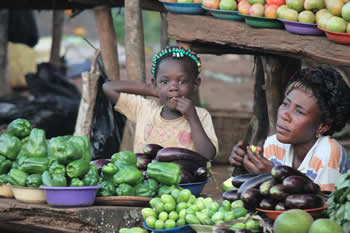
Malnutrition is thought to be responsible for 45 percent of deaths in children under five. Despite worldwide efforts to reach the Millennium Development Goal target of halving the proportion of people who suffer from hunger by 2015, 165 million children remain stunted and 870 million people are chronically undernourished globally.
The 2013 Lancet Series on Maternal and Child Nutrition points to a growing consensus that combating the global burden of malnutrition will require collaboration across development sectors. With the potential of integrated programming to achieve sustainable improvements in nutrition, there is renewed interest and investment in understanding how agriculture—a sector which employs many of the world’s poor and malnourished—might better contribute to improved nutritional status.
Leveraging the links between agriculture and nutrition outcomes is a core component of SPRING’s strategic framework (PDF, 952 KB). However, the dynamics between agriculture and nutrition are complicated, and evidence linking targeted agricultural interventions to improved nutrition is in demand. A number of frameworks have emerged and include IFPRI's Seven Key Pathways from Agriculture to Nutrition (PDF, 228 KB) and the FAO’s Guiding Principles for Linking Agriculture and Nutrition. Agriculture provides food, increasing food availability and access; provides income, from wages and marketing of commodities produced; affects food prices, affecting income of net sellers and purchasing power of net buyers; can affect women’s social status and empowerment, women’s time, and can affect and be affected by women’s health and nutritional status.
SPRING used these frameworks to complete a review and analysis of the projects being undertaken in USAID’s 19 Feed the Future countries to determine where opportunities for increasing nutritional outcomes through Feed the Future investments might be improved. This analysis provided the backdrop for a series of five regional Agriculture-Nutrition Global Learning and Evidence Exchange events that SPRING, in conjunction with USAID’s Bureau for Food Security and Bureau for Global Health, led in Uganda, Guatemala, Thailand, and the United States between December 2012 and July 2013. The learning resulting from the analysis and workshops are informing an ambitious agenda over the coming years to:
- Collaborate with a range of partners to identify key operations research topics to be investigated within Feed the Future and other integrated food security activities that have a goal of reducing undernutrition.
- Draw on a team of experts from both the agriculture and nutrition sectors, to develop global technical guidance documents to assist USAID staff and implementing partners obtain measurable nutritional outcomes from both new and existing activities.
- Provide technical assistance to USAID Missions on a range of multi-sectoral, nutrition-sensitive design, implementation and monitoring challenges including, for example, how to develop social and behavior change communication strategies that most effectively link agriculture and nutrition behaviors.